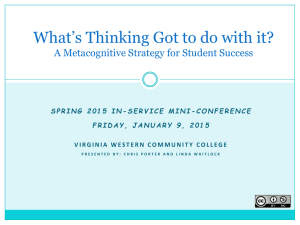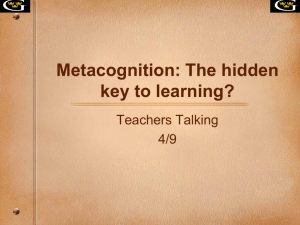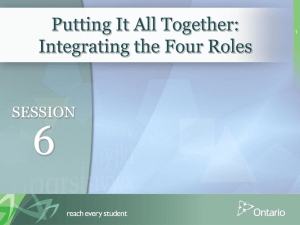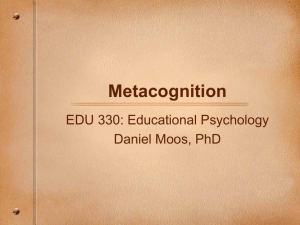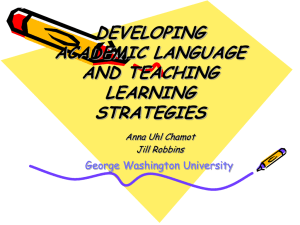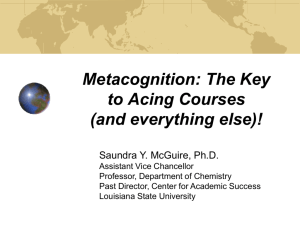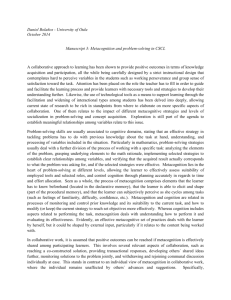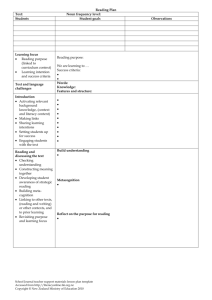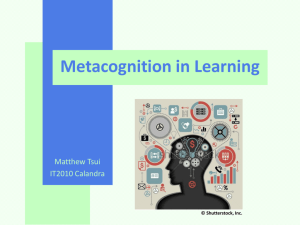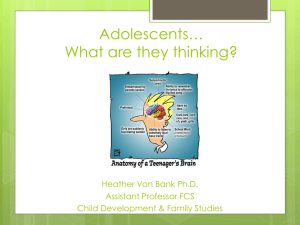Metacognition: A Literature Review Research Report
advertisement
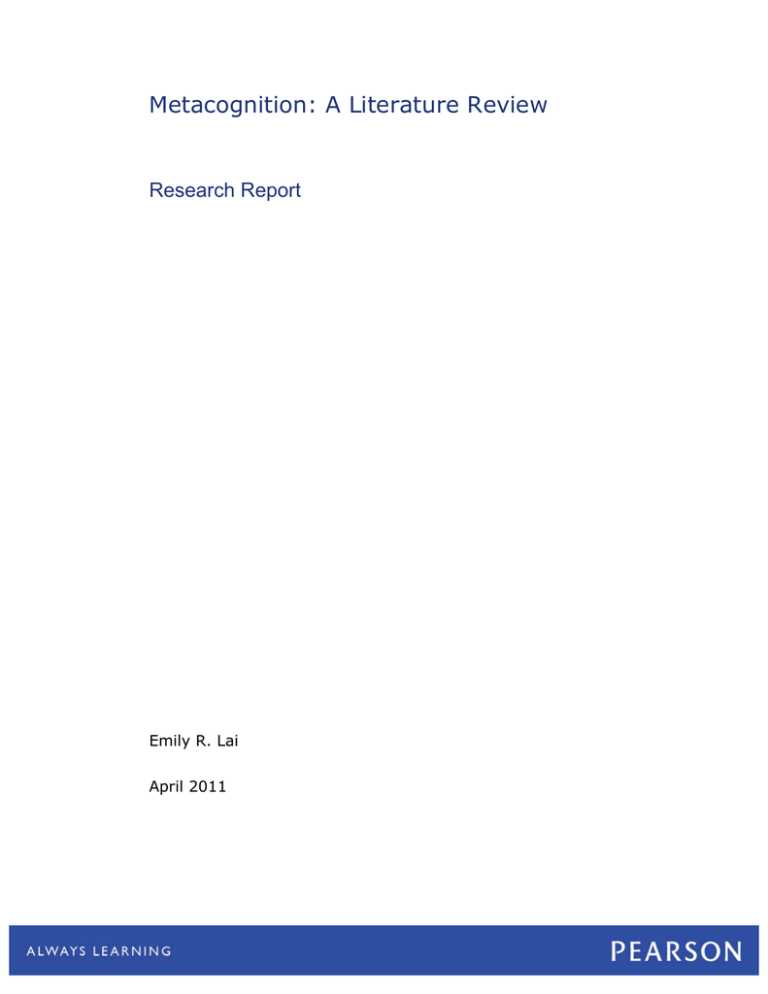
Metacognition: A Literature Review Research Report Emily R. Lai April 2011 METACOGNITION About Pearson Pearson, the global leader in education and education technology, provides innovative print and digital education materials for preK through college, student information systems and learning management systems, teacher licensure testing, teacher professional development, career certification programs, and testing and assessment products that set the standard for the industry. Pearson’s other primary businesses include the Financial Times Group and the Penguin Group. For more information about the Assessment & Information group of Pearson, visit http://www.pearsonassessments.com/. About Pearson’s Research Reports Pearson’s research report series provides preliminary dissemination of reports and articles prepared by TMRS staff, usually prior to formal publication. Pearson’s publications in .pdf format may be obtained at: http://www.pearsonassessments.com/research. 1 METACOGNITION 2 Abstract Metacognition is defined most simply as “thinking about thinking.” Metacognition consists of two components: knowledge and regulation. Metacognitive knowledge includes knowledge about oneself as a learner and the factors that might impact performance, knowledge about strategies, and knowledge about when and why to use strategies. Metacognitive regulation is the monitoring of one’s cognition and includes planning activities, awareness of comprehension and task performance, and evaluation of the efficacy of monitoring processes and strategies. Recent research suggests that young children are capable of rudimentary forms of metacognitive thought, particularly after the age of 3. Although individual developmental models vary, most postulate massive improvements in metacognition during the first 6 years of life. Metacognition also improves with appropriate instruction, with empirical evidence supporting the notion that students can be taught to reflect on their own thinking. Assessment of metacognition is challenging for a number of reasons: (a) metacognition is a complex construct; (b) it is not directly observable; (c) it may be confounded with both verbal ability and working memory capacity; and (d) existing measures tend to be narrow in focus and decontextualized from inschool learning. Recommendations for teaching and assessing metacognition are made. Keywords: metacognition, self-regulated learning METACOGNITION 3 Acknowledgements The author would like to thank Janet Fowler for assistance in conducting literature searches and the following reviewers for their helpful comments and suggestions on an earlier draft of this paper: Jennifer Beimers, Bob Dolan, and Cip Muñoz. METACOGNITION 4 Metacognition: A literature review Educational psychologists have long promoted the importance of metacognition for regulating and supporting student learning. More recently, the Partnership for 21st Century Skills has identified self-directed learning as one of the life and career skills necessary to prepare students for post-secondary education and the workforce. However, educators may not be familiar with methods for teaching and assessing metacognition, particularly among elementaryaged children. The purpose of this literature review is fourfold: (1) to explore the ways in which metacognition has been defined by researchers; (2) to investigate how metacognition develops in young children; (3) to learn how teachers can encourage development of metacognitive skills in their students; and (4) to review best practices in assessing metacognition. Definition of Metacognition John Flavell originally coined the term metacognition in the late 1970s to mean “cognition about cognitive phenomena,” or more simply “thinking about thinking” (Flavell, 1979, p. 906). Subsequent development and use of the term have remained relatively faithful to this original meaning. For example, researchers working in the field of cognitive psychology have offered the following definitions: “The knowledge and control children have over their own thinking and learning activities” (Cross & Paris, 1988, p. 131) “Awareness of one’s own thinking, awareness of the content of one’s conceptions, an active monitoring of one’s cognitive processes, an attempt to regulate one’s cognitive processes in relationship to further learning, and an METACOGNITION 5 application of a set of heuristics as an effective device for helping people organize their methods of attack on problems in general” (Hennessey, 1999, p. 3) “Awareness and management of one’s own thought” (Kuhn & Dean, 2004, p. 270) “The monitoring and control of thought” (Martinez, 2006, p. 696) As Kuhn and Dean (2004) explain, metacognition is what enables a student who has been taught a particular strategy in a particular problem context to retrieve and deploy that strategy in a similar but new context. The authors note that in cognitive psychology, metacognition is often defined as a form of executive control involving monitoring and self-regulation, a point echoed by other researchers (McLeod, 1997; Schneider & Lockl, 2002). Further, Schraw (1998) describes metacognition as a multidimensional set of general, rather than domain-specific, skills. These skills are empirically distinct from general intelligence, and may even help to compensate for deficits in general intelligence and/or prior knowledge on a subject during problem solving. Constituent Elements of Metacognition Metacognition has two constituent parts: knowledge about cognition and monitoring of cognition (Cross & Paris, 1988; Flavell, 1979; Paris & Winograd, 1990; Schraw & Moshman, 1995; Schraw et al., 2006; Whitebread et al., 1990). Several frameworks have been developed for categorizing types of knowledge about cognition. Table 1 organizes components from each of these frameworks to facilitate comparisons among them. For example, Flavell (1979) defines cognitive knowledge as knowledge about one’s own cognitive strengths and limitations, including the factors (both internal and external) that may interact to affect cognition. He classifies such knowledge into three types: (1) “person” knowledge, which includes anything one METACOGNITION 6 believes about the nature of human beings as cognitive processors; (2) “task” knowledge, which includes knowledge about the demands of different tasks; and (3) “strategy” knowledge, which is knowledge about the types of strategies likely to be most useful. Flavell notes that these different types of knowledge can interact, as in the belief that one should use strategy A (versus strategy B) to solve task X (rather than task Y). METACOGNITION 7 Table 1 Typology of Metacognitive Components Metacognitive Component Type Knowledge about oneself as a learner and factors affecting cognition Cognitive knowledge Awareness and management of cognition, including knowledge about strategies Knowledge about why and when to use a given strategy Identification and selection of appropriate strategies and allocation of resources Cognitive regulation Attending to and being aware of comprehension and task performance Assessing the processes and products of one’s learning, and revisiting and revising learning goals Terminology Person and task knowledge Self-appraisal Epistemological understanding Declarative knowledge Procedural knowledge Citation Flavell, 1979 Paris & Winograd, 1990 Kuhn & Dean, 2004 Cross & Paris, 1988 Schraw et al., 2006 Schraw & Moshman, 1995 Cross & Paris, 1988 Kuhn & Dean, 2004 Schraw et al., 2006 Strategy knowledge Flavell, 1979 Conditional knowledge Schraw et al., 2006 Planning Monitoring or regulating Cross & Paris, 1988 Paris & Winograd, 1990 Schraw et al., 2006 Schraw & Moshman, 1995 Whitebread et al., 2009 Cross & Paris, 1988 Paris & Winograd, 1990 Schraw et al., 2006 Schraw & Moshman, 1995 Whitebread et al., 2009 Cognitive experiences Flavell, 1979 Evaluating Cross & Paris, 1988 Paris & Winograd, 1990 Schraw et al., 2006 Schraw & Moshman, 1995 Whitebread et al., 2009 METACOGNITION 8 Subsequent metacognition researchers have offered a slightly different framework for categorizing cognitive knowledge. For example, several researchers have used the concepts of declarative and procedural knowledge to distinguish cognitive knowledge types (Cross & Paris, 1988; Kuhn, 2000; Schraw et al., 2006; Schraw & Moshman, 1995). Kuhn and Dean (2004) characterize declarative cognitive knowledge broadly as epistemological understanding, or the student’s understanding of thinking and knowing in general. Schraw et al. (2006) portray declarative cognitive knowledge as knowledge about oneself as a learner and what factors might influence one’s performance. Paris and Winograd (1990) discuss the process of self-appraisal as reflection about personal knowledge states to answer the question, “Do I know this?” Finally, Cross and Paris (1988) define declarative cognitive knowledge specifically within the context of reading as awareness of the factors that might affect reading ability. On the other hand, procedural knowledge involves awareness and management of cognition, including knowledge about strategies (Cross & Paris, 1988; Kuhn & Dean, 2004; Schraw et al., 2006). Schraw et al. (2006) also distinguish conditional cognitive knowledge, which is knowledge of why and when to use a given strategy. The authors point out that cognitive knowledge is “late developing,” in the sense that children often exhibit deficits in cognitive knowledge. In addition, although the ability to explicitly articulate cognitive knowledge tends to improve with age, many adults struggle to explain what they know about their thinking. This latter result suggests that cognitive knowledge may not need to be explicit in order for people to access and use it. The other component of metacognition is monitoring of one’s cognition, which many researchers have argued includes activities of planning, monitoring or regulating, and evaluating (Cross & Paris, 1988; Paris & Winograd, 1990; Schraw & Moshman, 1995; Schraw et al., 2006; METACOGNITION 9 Whitebread et al., 2009). Planning involves identification and selection of appropriate strategies and allocation of resources, and can include goal setting, activating background knowledge, and budgeting time. Monitoring or regulating involves attending to and being aware of comprehension and task performance and can include self-testing. Finally, evaluation is defined as “appraising the products and regulatory processes of one’s learning,” and includes revisiting and revising one’s goals (Schraw et al., 2006, p. 114). Flavell (1979) discusses cognitive monitoring in the context of “cognitive experiences,” which are insights or perceptions that one experiences during cognition, such as, “I’m not understanding this.” Flavell notes that these experiences serve as “quality control” checks that help learners revise their goals. Haller et al. (1988) identify three clusters of mental activity inherent in metacognition within the context of reading comprehension, including awareness, monitoring, and regulating. According to this framework, awareness entails recognition of explicit and implicit information and responsiveness to text dissonance or inaccuracies. Monitoring involves goal setting, self-questioning, paraphrasing, activating relevant background knowledge, making connections between new and previously learned content, and summarizing to enhance comprehension during reading. Finally, regulating refers to “compensatory strategies to redirect and bolster faltering comprehension” (p. 6). Researchers have observed a relationship between cognitive knowledge and cognitive monitoring. For example, Flavell (1979) argues that metacognitive experiences that allow one to monitor and regulate one’s cognition play a major role in the development and refinement of metacognitive knowledge. In turn, Schraw (1998) cites a number of empirical studies demonstrating that cognitive knowledge appears to facilitate cognitive regulation. He notes that such studies have found cognitive knowledge and cognitive regulation to be correlated with one METACOGNITION 10 another at about r = .50, which suggests that around one-quarter of the variance in cognitive knowledge is attributable to cognitive regulation and vice versa. Further, Schraw and Moshman (1995) argue that cognitive knowledge and cognitive regulation are integrated in metacognitive theories. There are three types of such theories, which individuals construct in order to systematize cognitive knowledge and plan cognitive activities. Tacit theories are constructed without explicit awareness from personal experiences or interactions with peers. These theories may be difficult to change precisely because they are implicit. Informal theories are characterized as “fragmentary“; in other words, individuals may be aware of some aspects of these theories, but lack an explicit structure for organizing their beliefs about knowledge. Over time, these informal theories are expected to become more sophisticated and formalized. Finally, formal theories are highly systematized and structured. These theories are rare, and because they are explicit, more subject to “purposeful and rigorous evaluation” (Schraw & Moshman, 1995, p. 362). Relationship to Other Concepts Researchers in cognitive psychology have linked metacognition to a number of other constructs, including metamemory, critical thinking, and motivation. For example, metamemory is closely related to metacognition, particularly cognitive knowledge. Metamemory is “knowledge about memory processes and contents,” and consists of two components that closely mirror the declarative and procedural aspects of cognitive knowledge (Schneider & Lockl, 2002, p. 5). Variables, which correspond to declarative knowledge, refer to “explicit, conscious, factual knowledge that performance in a memory task is influenced by a number of different factors or variables” (p. 6). Sensitivity, which corresponds to procedural knowledge, is knowledge about when a particular memory strategy might be useful. According to Schneider and Lockl (2002), METACOGNITION 11 most developmental studies of metacognition have actually focused on the construct of metamemory, particularly its procedural dimension. Critical thinking also relates to metacognition. Definitions of critical thinking vary widely, but common elements of most definitions include the following component skills: analyzing arguments (Ennis, 1985; Facione, 1990; Halpern, 1998; Paul, 1992); making inferences using inductive or deductive reasoning (Ennis, 1985; Willingham, 2007; Paul, 1992; Facione, 1990); judging or evaluating (Case, 2005; Ennis, 1985, Facione, 1990; Lipman, 1988; Tindal & Nolet, 1995); making decisions or solving problems (Ennis, 1985; Halpern, 1998; Willingham, 2007). In addition to skills or abilities, critical thinking also entails dispositions. These dispositions, which can be seen as attitudes or habits of mind, include open- and fairmindedness, inquisitiveness, flexibility, a propensity to seek reason, a desire to be well-informed, and a respect for and willingness to entertain diverse viewpoints (Bailin et al., 1999; Ennis, 1985; Facione, 1990; Halpern, 1998; Paul, 1992). Finally, there appear to be both general and domainspecific aspects of critical thinking, which suggests that instruction should represent a fusion of preparation in general critical thinking principles, as well as practice in applying critical thinking skills within the context of specific domains (Ennis, 1989; Facione, 1990; Paul, 1992). Flavell (1979) and Martinez (2006) maintain that critical thinking is subsumed under metacognition. For example, Flavell argues that the definition of metacognition should include METACOGNITION 12 critical thinking when he argues that “critical appraisal of message source, quality of appeal, and probable consequences needed to cope with these inputs sensibly” can lead to “wise and thoughtful life decisions” (p. 910). Martinez defines critical thinking as “evaluating ideas for their quality, especially judging whether or not they make sense,” and sees it as one of three types of metacognition, along with metamemory and problem solving (p. 697). Kuhn (1999) equates critical thinking with metacognition. Similarly, Hennessey (1999) identifies a list of metacognitive skills that are quite similar to skills commonly included in definitions of critical thinking: considering the basis of one’s beliefs; temporarily bracketing one’s conceptions in order to assess competing conceptions; considering the relationship between one’s conceptions and any evidence that might or might not support those conceptions; considering explicitly the status of one’s own conceptions; evaluating the consistency and generalizability inherent in one’s conceptions. Schraw et al., however, see both metacognition and critical thinking as being subsumed under self-regulated learning, which they define as “our ability to understand and control our learning environments” (p. 111). Self-regulated learning entails metacognition, motivation, and cognition, which includes critical thinking (2006). At the very least, metacognition can be seen as a supporting condition for critical thinking, to the extent that monitoring the quality of one’s thought makes it more likely that one will engage in high-quality (critical) thinking. METACOGNITION 13 Finally, several researchers highlight the link between metacognition and motivation (Cross & Paris, 1988; Eisenberg, 2010; Martinez, 2006; Paris & Winograd, 1990; Ray & Smith, 2010; Schraw et al., 2006; Whitebread et al., 2009). Paraphrasing Gredler, Broussard and Garrison define motivation as “the attribute that moves us to do or not to do something” (2004, p. 106). Gottfried defines academic motivation in particular as the “enjoyment of school learning characterized by a mastery orientation; curiosity; persistence; task-endogeny; and the learning of challenging, difficult, and novel tasks” (1990, p. 525). In the context of metacognition, motivation is defined as “beliefs and attitudes that affect the use and development of cognitive and metacognitive skills” (Schraw et al., 2006, p. 112). According to Schraw et al. (2006) motivation has two primary subcomponents: (1) self-efficacy, which is confidence in one’s ability to perform a specific task and (2) epistemological beliefs, which are beliefs about the origin and nature of knowledge. Cross and Paris (1988) note that metacognition includes affective and motivational states. Similarly, Martinez (2006) argues that metacognition entails the management of affective states, and that metacognitive strategies can improve persistence and motivation in the face of challenging tasks. Paris and Winograd (1990) concur, arguing that affect is an inevitable element of metacognition, because as students monitor and appraise their own cognition, they will become more aware of strengths and weaknesses. Eisenberg (2010) reviews the research on young children’s emotion-related selfregulation, which is the set of “processes used to manage and change if, when, and how one experiences emotions and emotion-related motivation and physiological states and how emotions are expressed behaviorally” (p. 681). This emotion-related self-regulation refers to monitoring and regulating the impact of emotions and motivational states on one’s performance and parallels the regulation of cognition involved in the executive functioning dimension of metacognition. METACOGNITION 14 Eisenberg defines one subskill, known as effortful control (EC), as “the efficiency of executive attention—including the ability to inhibit a dominant response and/or activate a subdominant response, to plan, and to detect errors” (p. 682). Eisenberg argues that EC is indirectly related to academic success through motivation. Eisenberg explains the relationship as follows: children high in EC are more likely to behave in productive, pro-social ways; they are more socially competent and are generally rated as having higher quality interactions with others. Such prosocial children are more likely to engage in school to the extent that they feel socially comfortable. This increased motivation is then hypothesized to lead to higher achievement. Eisenberg concludes that the extant empirical research tends to support this proposed link, suggesting that interventions designed to improve students’ EC may lead to better peer interactions, higher engagement with schoolwork, and improved learning outcomes. For example, preschoolers’ EC predicted future SAT scores and also correlated with interpersonal skills and motivation. Ray and Smith (2010) echo this conclusion, arguing that EC predicts kindergarten students’ future reading and math abilities. Development of Metacognition This section reviews the empirical literature on the metacognitive capacities of preK and elementary-aged children, followed by an investigation of how metacognitive capacities appear, develop, and improve over time with age. Empirical Evidence on the Metacognitive Skills of Young Children Research in the Piagetian tradition has been quite influential in shaping expectations of young children’s metacognitive capacity (McLeod, 1997). Researchers studying Piaget’s work have often concluded that young children are not capable of formal operations, which are METACOGNITION 15 necessary for abstract thought. Accordingly, as noted by several researchers, early studies on the metacognitive capacities of young children tended to conclude, rather pessimistically, that metacognition is a late-developing skill (Flavell, 1979; Schraw & Moshman, 1995; Whitebread et al., 2009). Indeed, accepted wisdom held that children typically do not develop metacognitive skills before 8-10 years of age (Whitebread et al., 2009). Summarizing the results of early studies in metamemory, Flavell (1979) argues that young children have difficulty appraising their own ability to memorize a set of objects and identifying what they do and do not understand about a set of written instructions. Schraw and Moshman (1995) note that young children have difficulty monitoring their thinking during task performance and constructing metacognitive theories— frameworks that integrate cognitive knowledge and cognitive regulation. Planning also appears to be a late-developing skill, with dramatic improvements in the ability to select appropriate strategies and allocate resources not appearing until 10-14 years of age. However, more recent empirical work has cast doubt on the conclusions of earlier studies. For example, Schraw and Moshman (1995) observe that, although cognitive knowledge tends to improve with age, by the age of 4, children are able to theorize about their own thinking at a very simple level and appear to use simple theories to regulate their learning. Similarly, Whitebread et al. (2009) found that children as young as 3-5 years old exhibited both verbal and nonverbal metacognitive behaviors during problem solving, including articulation of cognitive knowledge, cognitive regulation, and regulation of emotional and affective states. McLeod (1997) points out that researchers have observed metacognition even in preschool-aged children, in the form of planning and monitoring progress toward goals and persistence at challenging tasks. Moreover, children as young as 6 can reflect with accuracy on their cognition (Schraw & METACOGNITION 16 Moshman, 1995), and Hennessey (1999) observed first-grade students evaluating the plausibility of their science conceptions. Schneider (2008) followed 174 children from the ages of 3 to 5, investigating the relationship between theory of mind at age 3 and subsequent development of metamemory. Theory of mind (ToM) refers to the “ability to estimate mental states, such as beliefs, desires, or intentions, and to predict other people’s performance based on judgments of their mental states” (p. 115). Schneider also examined the role of language ability in the development of metamemory. He found that both ToM and language ability increased steadily with age. Further, there was a strong relationship between language ability and both ToM and metamemory. Strong language ability at age 3 was a salient predictor of metamemory at age 5. Schneider hypothesizes that ToM facilitates the acquisition of metacognitive knowledge and vocabulary in young children, arguing that “early ToM competencies can be considered as a precursor of subsequent metamemory” (p. 116). Although results suggest that declarative metacognitive knowledge tends to increase with age, developmental trends for procedural metacognitive knowledge, particularly as it relates to monitoring task demands in relation to abilities, were less clear. Young children’s ToM abilities may, in turn, depend on their capacity for executive functioning. To the extent that metacognition entails planning, self-regulation of both cognition and affective or motivational states, and allocation of attention and other intellectual resources, executive functioning forms part of the construct. Investigating the relationship between inhibitory control and ToM in preschool children, Carlson and Moses (2001) argue that executive functioning may be a prerequisite skill for the development of metacognition. Inhibitory control (IC) is “the ability to inhibit responses to irrelevant stimuli while pursuing a cognitively represented goal” (p. 1033). Studies investigating children’s IC have typically used METACOGNITION 17 measures such as a child’s ability to delay gratification or to suppress dominant impulses to respond to tasks in certain preprogrammed ways when instructed to do so. Empirical research suggests that significant development of IC abilities occurs during the first 6 years of life, with noticeable improvements occurring between the ages of 3 and 6. This development parallels maturation of the brain, particularly areas responsible for executive functioning. Carlson and Moses investigated the relationship between IC and ToM in 107 students from the ages of 3 to 4. They found ToM ability to significantly improve with age. Further, IC and ToM were significantly related, even after controlling for age, gender, and verbal ability. The authors speculate, and found some evidence to support, the possibility that both IC and working memory capacity mediate the relationship between general executive functioning and ToM. Development of Metacognition Over Time Kuhn (2000) characterizes development of metacognition as the very gradual (and not always unidirectional) movement to acquire better cognitive strategies to replace inefficient ones. Several researchers have concluded that metacognitive abilities appear to improve with age (Cross & Paris, 1988; Hennessey, 1999; Kuhn & Dean, 2004; Schneider, 2008; Schneider & Lockl, 2002; Schraw & Moshman, 1995). Schraw and Moshman (1995) posit that metacognitive development proceeds as follows: cognitive knowledge appears first, with children as young as age 6 able to reflect on the accuracy of their cognition, and consolidation of these skills typically evident by 8-10 years of age. Ability to regulate cognition appears next, with dramatic improvements in monitoring and regulation appearing by 10-14 years of age in the form of planning. Monitoring and evaluation of cognition are slower to develop and may remain incomplete in many adults. Finally, the construction of metacognitive theories appears last (if at all). These theories allow for the integration of cognitive knowledge and cognitive regulation. METACOGNITION 18 Children spontaneously construct these theories as they come to reflect on their own thinking and learning. Metacognitive theories tend to originate within a particular domain, and to gradually extend to other domains. These theories begin as implicit and informal, becoming more systematized and formalized over time. Kuhn and Dean (2004) portray epistemological understanding as a benchmark in the development of metacognition. According to this developmental framework, preschool children are realists, who equate believing with knowing. In other words, young children believe that everyone perceives the same thing, and all perceptions match external reality. By around age 4, however, children learn that some beliefs can be wrong. At this stage, called absolutism, children learn that two people’s beliefs can differ, but only because one person is right and the other is wrong. By adolescence, most people recognize that even experts can disagree on certain topics. At this point, many descend into multiplism (or complete relativism), where everything is subjective, no beliefs can be judged, and all opinions are equally right. By adulthood, many people will have learned to tolerate some uncertainty, while still maintaining that there can be better or worse opinions to the extent that they are supported with reason and evidence (evaluative epistemology). Kuhn and Dean argue that there is very little that needs to be done to encourage children to progress through the first three stages; rather, it is progression to the fourth stage that requires some instructional effort. Finally, Schneider and Lockl (2002) link development of metacognition with development of declarative metamemory, first evidenced by a child’s understanding of mental verbs such as “know,” “think,” “remember,” and “forget.” Preschoolers and kindergartners appear to have a limited understanding of memory, but they seem to understand the terms. From the age of 4 years on, memory verbs can be correctly applied to describe mental states. Between METACOGNITION 19 the ages of 6 and 11, there appear to be large gains in procedural metamemory knowledge. Prior to this time, children tend to over-estimate their memory performance, believing that performance is linked more strongly to effort than it actually is. By the age of 9 or 10, most children realize that task characteristics and use of strategies can make remembering more or less difficult, and students by the age of 12 can make more subtle distinctions in the differential effectiveness of various memory strategies. By this time, students are also able to self-regulate efficiently, in terms of allocating study time and attention. Development of strategic knowledge continues through adolescence and young adulthood, when students learn about interactions between memory variables, such as task characteristics, strategies, and effort. There is at least some evidence, however, that general metacognition does not necessarily increase with age. Sperling et al. (2002) developed and administered a self-report instrument for measuring general metacognitive knowledge and regulation in children in grades 3-8. Empirical results validated the instrument’s multidimensional approach to conceptualizing metacognition. In addition, the measure was significantly related to other, published measures of metacognition and only weakly correlated with measures of achievement. However, researchers found that mean scores on these instruments either decreased or stayed the same across grade levels. Thus, there was a slight tendency for younger students to earn higher metacognition scores than older students. The researchers speculated that because the instrument measures general metacognition rather than metacognition in the context of a specific subject, perhaps metacognition becomes more domain-specific as students age and acquire more specialized content knowledge. The study provided at least some support for this speculation, as correlations between scores on the self-report instrument and teachers’ ratings of students’ metacognition appeared to be weaker for older students (whose ratings were completed by teachers responsible for a single subject area) METACOGNITION 20 than they were for younger students (whose ratings were completed by teachers responsible for multiple subject areas). In addition, the relationship between general metacognition and achievement in reading and math was weaker for older students than it was for younger students. Thus, it is possible that metacognition is domain-general among younger students, but gradually becomes more domain-specific for older students. Instructional Implications This section reviews the empirical evidence on the “teachability” of metacognitive skills, followed by a summary of specific instructional recommendations for fostering the development of metacognition. Empirical Evidence on Teaching Metacognition Several researchers offer evidence that metacognition is teachable (Cross & Paris, 1988; Dignath et al., 2008; Haller et al., 1988; Hennessey, 1999; Kramarski & Mevarech, 2003). For example, Cross and Paris (1988) describe an intervention targeted at improving the metacognitive skills and reading comprehension of 171 students in third and fifth grades. Children were exposed to a curriculum (Informed Strategies for Learning) designed to increase their awareness and use of effective reading strategies. During instruction, students received strategy training that included explicit attention to declarative, procedural, and conditional knowledge about reading strategies. Students in both grades made significant gains relative to comparison students with regard to awareness about reading in three areas—evaluation of task difficulty and one’s own abilities, planning to reach a goal, and monitoring progress towards the goal. METACOGNITION 21 Dignath et al. (2008) meta-analyzed 48 studies investigating the effect of training in selfregulation on learning and use of strategies among students in first through sixth grades. Table 2 reports selected effect sizes for the various types of interventions. Table 2 Summary of Selected Results from Dignath et al., 2008 Type of Treatment Any self-regulation training (metacognitive, cognitive, and motivational) Mean Effect Size 0.73 Metacognitive and motivational strategies training (all strategies) 0.97 Metacognitive and cognitive strategies training (all strategies) 0.81 Metacognitive strategies training (all strategies) 0.54 Metacognitive strategy training in planning and monitoring 1.50 Metacognitive strategy training in planning and evaluation 1.46 Training on metacognitive reflection – knowledge about and value of strategies 0.95 Cognitive strategies training (all strategies) 0.58 Cognitive strategy training in elaboration 1.19 Cognitive strategy training in elaboration, organization, problem solving 0.94 Cognitive strategy training in problem solving 0.72 The overall effect size for all studies examining the effect of any type of self-regulation training on the use of cognitive or metacognitive strategies was 0.73. Training that specifically emphasized metacognitive strategies had an effect size of 0.54. Training approaches that combined metacognitive components with other aspects of self-regulation, such as cognitive or motivational strategies, were even more successful, with average effect sizes of 0.81 and 0.97, respectively. The most successful cognitive strategies included elaboration taught in isolation (mean effect size = 1.19), followed by a combination of elaboration, organization, and problem METACOGNITION 22 solving strategies (mean effect size = 0.94) and problem solving taught in isolation (mean effect size = 0.72). The most effective metacognitive strategies included the combination of planning and monitoring (mean effect size = 1.50) and the combination of planning and evaluation (mean effect size = 1.46), both of which were more successful than teaching any of the skills in isolation or teaching a combination of all three metacognitive skills (planning, monitoring, and evaluation). In studies where the intervention also included instruction designed to promote student metacognitive reflection, the most effective type of instruction emphasized a combination of knowledge about strategies as well as specific benefits of those strategies (mean effect size = 0.95). Haller et al. (1988) meta-analyzed 20 empirical studies, comprising more than 1,500 students, on the effects of metacognitive instruction on students’ metacognition during reading. They computed a mean effect size of 0.71, which suggests that instruction in metacognition can have robust effects on children’s reading awareness and comprehension. Effects were largest for students in the seventh and eighth grades, but were also impressive among students in the second and third grades. The most modest effect sizes were found among students in fourth through sixth grades. Results suggest that instructional interventions involving fewer than 10 minutes of instruction per lesson are insufficient for producing these types of effects. The most effective instructional strategies included the textual-dissonance approach, self-questioning, and backward-forward search strategies, although the authors recommend using a variety of diverse techniques for best results. Hennessey (1999) describes an instructional program involving 170 students in grades 1 through 6 over a period of three years. Students engaged in science units designed to explore students’ science conceptions and the nature of science, with activities focusing specifically on METACOGNITION 23 development of metacognition. Teachers’ instruction emphasized making students’ science conceptions visible, creating opportunities for students to clarify their conceptions in small groups, promoting metacognitive discourse among students, encouraging conceptual conflict, and facilitating student practice in different contexts. Hennessey concludes that students did exhibit qualitative changes in their metacognitive abilities from one year to the next, with students as young as first graders exhibiting the highest level of metacognition. Finally, Kramarski and Mevarech (2003) report the results of a study investigating the effects of metacognitive training on the mathematical reasoning and metacognitive skills of 384 eighth-grade students. They found that students exposed to metacognitive instruction in either cooperative or individualized learning environments outperformed comparison students with respect to the ability to interpret graphs, fluency and flexibility of correct mathematical explanations, use of logical arguments to support math reasoning, performance on transfer tasks, and level of domain-specific metacognitive knowledge, such as strategies for representing math concepts in multiple ways and specific mathematical strategies for interpreting graphs. Specific Instructional Strategies Researchers have recommended a number of specific instructional approaches to teaching metacognition. For example, many researchers have noted the importance of providing explicit instruction in both cognitive knowledge and cognitive regulation. Cross and Paris (1988) recommend providing explicit instruction in declarative, procedural, and conditional knowledge. Similarly, Schraw et al. (2006) and Schraw (1998) urge educators to provide explicit instruction in cognitive and metacognitive strategies. Further, Schraw emphasizes that such strategy training needs to emphasize how to use strategies, when to use them, and why they are beneficial. A METACOGNITION 24 number of other researchers echo the importance of highlighting the value of particular strategies in order to motivate students to use them strategically and independently (Cross & Paris, 1988; Kramarski & Mevarech, 2003; Schneider & Lockl, 2002). In addition to providing instruction on cognitive knowledge, educators should also assist students in developing their abilities to monitor and regulate their cognition. Most of these recommendations concern the level of teacher scaffolding and structure provided. For example, Kuhn (2000) points out that instruction for metacognition should be delivered at the meta-level rather than the performance level, which means instruction should be aimed at increasing awareness and control of meta-task, rather than task, procedures. Schraw (1998) recommends providing explicit prompts to help students improve their regulating abilities. He suggests using a checklist with entries for planning, monitoring, and evaluation, with subquestions included under each entry that need to be addressed during the course of instruction. Such a checklist, he argues, helps students to be more systematic and strategic during problem solving. Similarly, Kramarski and Mevarech (2003) provided students with sets of metacognitive questions, including comprehension questions, strategic questions, and connection questions, to be completed during the task. Comprehension questions were designed to encourage students to reflect on a problem before solving it. Strategic questions were designed to encourage students to think about what strategy might be appropriate for a given task and to provide a reason or rationale for that strategy choice. Finally, connection questions were designed to encourage students to identify and recognize deep-structure task attributes so that they could activate relevant strategy and background knowledge. Researchers also recommend the use of collaborative or cooperative learning structures for encouraging development of metacognitive skills (Cross & Paris, 1988; Hennessey, 1999; METACOGNITION 25 Kramarski & Mevarech, 2003; Kuhn & Dean, 2004; Martinez, 2006; McLeod, 1997; Paris & Winograd, 1990; Schraw & Moshman, 1995; Schraw et al., 2006). This recommendation appears to be rooted in Piagetian and Vygotskyian traditions that emphasize the value of social interactions for promoting cognitive development (as summarized in Dillenbourg et al., 1996). Piaget touted the instructional value of cognitive conflict for catalyzing growth, typically achieved by interacting with another person at a higher developmental stage. Along similar lines, Vygotsky identified the zone of proximal development as the distance between what an individual can accomplish alone and what he/she can accomplish with the help of a more capable other (either a peer or adult). Each of these approaches highlights the potential for cognitive improvement when students interact with one another. Proponents of collaborative learning approaches include Cross and Paris (1988), who identify group discussions about the use of reading strategies as one of the critical features of the Informed Strategies for Learning curriculum. Hennessey (1999) points out that such techniques promote metacognitive discourse among students and stimulate conceptual conflict. Such conflict can lead to clarifications of students’ beliefs and concepts. Similarly, Kramarski and Mevarech (2003) attribute the superior performance of students working in collaborative group settings to the higher quality of discourse observed among students working together. Students participating in cooperative learning expressed their mathematical ideas in writing more ably than did those who worked alone. Moreover, as Schraw and Moshman (1995) note, peer interaction can encourage the construction and refinement of metacognitive theories, which are frameworks for integrating cognitive knowledge and cognitive regulation. Kuhn and Dean (2004) argue that social discourse can cause students to “interiorize” processes of providing elaborations and explanations, which have been associated with improved learning outcomes. METACOGNITION 26 Schraw et al. (2006) point out that small group work should involve peers at a similar developmental level, because they can provide examples within the learner’s zone of proximal development. Further, they observe that collaborative learning works especially well when students have been explicitly taught how to collaborate, a point echoed by Kramarski and Mevarech (2003). Other instructional recommendations include making student reasoning, concepts, and beliefs visible (Hennessey, 1999) by having students construct conceptual or mental models of the phenomena under study. Construction of such models may facilitate conceptual change for students holding inappropriate science conceptions, particularly if the process of developing and refining such models produces cognitive disequilibrium or conflict (Schraw et al., 2006). Teachers are also urged to promote general awareness of metacognition by modeling metacognitive skills during instruction, perhaps by “thinking aloud” (Kramarski & Mevarech, 2003; Martinez, 2006; Schraw, 1998). Educators should not neglect the affective and motivational aspects of metacognition, including self-efficacy, learning attributions, and goal orientations (Schraw, 1998). According to Schraw, students may possess the requisite knowledge and skills, but fail to use them. “In general, successful students have a greater sense of selfefficacy, attribute their success to controllable factors such as effort and strategy use, and persevere when faced with challenging circumstances” (p. 122). Assessment Implications This section reviews challenges in assessing metacognition, describes extant methods of assessing or measuring metacognition, and identifies specific recommendations from the literature for measuring metacognition. METACOGNITION 27 Challenges in Assessing Metacognition Researchers have noted challenges in assessing metacognition. For example, metacognition is not directly observable in students (Sperling et al., 2002). First, Whitebread et al. (2009) argue that self-report methods, such as the use of rating scales or questionnaires that ask respondents to describe their use of particular strategies, rely too heavily on verbal ability. In addition, techniques that ask respondents to “think aloud” while engaging in a task do not capture implicit cognitive processes. In other words, subjects may not be aware of their cognitive knowledge and monitoring, which suggests that think-aloud methods may underestimate an individual’s metacognitive capacity. Moreover, these problems are compounded in preschooland elementary-aged children, whose verbal ability and working memory capacities are incompletely developed. Thus, self-report and think-aloud techniques may be especially likely to underestimate the metacognitive abilities of young children. Finally, metacognition is a complex construct, involving cognitive knowledge and cognitive regulation. Moreover, there are multiple types of cognitive knowledge (declarative, procedural, conditional) as well as different types of cognitive regulation (planning, monitoring or regulating, and evaluating). Metacognition also entails affective and motivational states, including concepts such as effortful control and inhibitory control. Schraw and Moshman (1995) note that such complexity makes unreliability an issue. Extant Assessment Methods Given the complexity of the construct, many researchers have chosen to focus on only one or a few aspects of metacognition. Thus, measurement and assessment instruments designed to capture metacognition have typically focused somewhat narrowly on only a single dimension METACOGNITION 28 of the construct. Furthermore, because metacognition is not a skill that is traditionally assessed regularly in school as part of the normal curriculum, many of these assessments have come from experimental studies where the skills are practiced in a lab environment that is somewhat artificial or contrived, in the sense that it is not connected to school learning. For example, some metacognition studies focus on metamemory. Flavell (1979) describes assessment tasks that asked children to study a set of items until they were sure they could remember them completely. Children were then tested on their ability to recall all the items. Another common task was to read a set of written instructions and indicate any omissions, mistakes, or areas of ambiguity. Schneider (2008) observes that the most studied type of procedural metamemory is self-monitoring. Assessments designed to capture this ability include ease of learning judgments, judgments of learning, and feelings of knowing. For example, ease of learning judgments typically ask students to study a set of test materials for a short amount of time and then assess their abilities to remember the material. After the students are tested on the material, their performances are compared to their initial predictions. Feeling of knowing judgments ask subjects to identify by name a series of pictures; when subjects cannot recall the word for a particular picture, they are asked whether they would be able to identify the word if it were shown to them. These predictions are then compared to their actual abilities to recognize the correct term among a list of options. Another indicator of procedural metamemory is allocation of study time. If subjects are given sets of material to memorize and are observed to allocate more study time to learning difficult concepts, this is an indication of strong selfmonitoring abilities. Finally, researchers have often investigated young children’s theory of mind using location-false belief, contents-false belief, deceptive pointing, and appearance-reality tasks METACOGNITION 29 (Carlson & Moses, 2003). Each of these tasks involves cognitive conflict in some way, in the sense that successful performance requires subjects to suppress impulsive responses and to produce a response that is incompatible with the dominant response. For example, in one standard location-false belief task, a child observes two puppets interacting. One puppet places an object in a specific location and then “leaves the room.” The second puppet moves the object to another, hidden location. When the first puppet re-enters the room, the subject is asked to predict where he will look for the object—in the original location or in the new, actual location. Similarly, in a standard contents-false belief task, children are shown a common, brand-name box of bandages and asked to predict what is inside. The box is then opened and children are shown that it actually contains crayons. Another investigator then enters the room and is shown the closed box. Children are asked to speculate about what the second experimenter believes is in the box. Deceptive pointing involves a similar setup where students observe an object being hidden in various locations and are then asked to deceive a third person about the object’s location by “deceptively” pointing to a null location. Finally, a standard appearance-reality task attempts to train children to respond “day” when shown a picture of the moon and “night” when shown a picture of the sun. Another common method for capturing metacognition is the use of self-report questionnaires or rating scales. Kramarski and Mevarech (2003) used a metacognitive questionnaire, assessing both general metacognition and what they called domain-specific metacognition (math strategies). Students were presented with a range of strategies and asked to indicate whether and how often they used the strategies, employing a 5-point Likert scale that ranged from “never” to “always.” Cross and Paris (1988) assessed children’s metacognitive reading skills using two different measures. The Reading Awareness Interview was designed to METACOGNITION 30 assess children’s awareness about reading in three areas: evaluation of task difficulty and one’s own abilities, planning to reach a goal, and monitoring progress towards the goal. The interview contained 33 Likert-scaled items and 19 open-ended questions. The authors also used a strategy rating task; strategies were read aloud and children were asked to rate the effect of each on reading comprehension using a 7-point scale ranging from “hurts a lot” to “helps a lot.” Sperling et al. (2002) administered the Junior Metacognitive Awareness Inventory to students in grades 3-9. Students in grades 3-5 responded to Version A, which was a self-report inventory with 12 statements such as, “I ask myself if I learned as much as I could have when I finish a task.” Students rated the frequency with which they used each strategy using a 3-point scale ranging from “never” to “always.” Students in grades 6-9 responded to Version B, which contained similar statements but more of them (18 total items). Students responding to Version B used a 5-point Likert scale to rate their agreement with each statement. Empirical results generally support the approach to defining metacognition as including both knowledge and regulation in that researchers obtained a 2-factor solution, with items loading essentially as hypothesized. Student performance on these measures correlated positively and significantly with other measures of metacognition, particularly for students in grades 3-5 (thus providing evidence of convergent validity). At the same time, scores on Versions A and B correlated only slightly with student achievement, thus providing discriminant validity evidence. A few studies have attempted to measure metacognition in a way that is more connected to in-school learning. For example, Hennessey (1999) studied metacognition in the context of school science. Students working in collaborative groups were taught to represent their science conceptions graphically, and were expected to be able to perform the following skills: METACOGNITION state their own beliefs about the topic consider the reasoning used to support their beliefs look for consistency among their views explore the implications of their views over a wide range of activities while 31 looking for commonalities explore abstract concepts, propositions, or theories by constructing physical representations of their views distinguish between plausible, intelligible, and fruitful (grades 4-6) or distinguish between understanding an idea and believing it to be true (grades 1-3) explicitly talk about the status of their conceptions (grades 4-6) explicitly refer to their own thinking or learning Hennessey developed six categories to characterize the various levels of metacognition evident in students’ discourse as they constructed or revised representations of their science conceptions. Hennessey used protocol analysis to code students’ metacognitive behaviors according to the following scheme: conceptions – any metacognitive statements in which the student expresses his or her conceptions reasoning – any statements where the student refers to reasoning to explain his/her conceptions METACOGNITION 32 implications – any statements in which the student is considering implications or limitations of his/her conceptions thinking process – any statements in which the student is considering his/her thinking/learning process status – any statement in which the student is commenting on the status of his/her conceptions (i.e., evaluating intelligibility, plausibility, fruitfulness of the concept) conceptual ecology – statements in which the student refers to or specifically uses any components of his/her conceptual ecology Whitebread et al. (2009) developed an observational checklist with 22 items to measure metacognition and self-regulation in children between the ages of 3 and 5. This checklist identifies a range of student behaviors—both verbal and nonverbal—theorized to represent metacognitive knowledge, metacognitive regulation, and emotional and motivational regulation. Teachers are to code metacognitive events observed during the course of individual or group learning by rating individual students on each behavior using a 4-point Likert scale ranging from “Always” to “Never.” The checklist, which was developed and subsequently validated in the classroom, has been found to have relatively high reliability, with 66-96% agreement between raters, depending on the level of the coding scheme used. General Suggestions for Assessing Metacognition A few researchers have offered general suggestions for measuring or assessing metacognition. For example, Schraw and Moshman (1995) favor verbal report methods because METACOGNITION 33 they allow researchers to access aspects of thinking that are not directly observable. On the other hand, Whitebread et al. (2009) argue that observational methods have advantages over self-report and think-aloud methods. Observational approaches record actual learner behaviors, which enables nonverbal behaviors to be taken into account. Further, observational techniques can record social processes that may be important in acquisition of metacognitive skills. Kramarski and Mevarech (2003) recommend using instructional tasks that are complex, allow multiple representations of concepts, and afford students opportunities to identify and resolve conceptual conflicts. Finally, Perry (1988) notes that writing activities, especially those involving students in all stages of the writing process (planning, drafting, editing, and revising) offer ample opportunities for self-regulated learning. Summary Metacognition is a multidimensional set of skills that involve “thinking about thinking.” Metacognition entails two components: metacognitive knowledge and metacognitive regulation. Metacognitive knowledge includes knowledge about oneself as a learner and about the factors that might impact performance (declarative), knowledge about strategies (procedural), and knowledge about when and why to use strategies (conditional). Metacognitive regulation is the monitoring of one’s cognition and includes planning activities, monitoring or awareness of comprehension and task performance, and evaluation of the efficacy of monitoring processes and strategies. Insights experienced while monitoring and regulating cognition play a role in the development and refinement of metacognitive knowledge. In turn, cognitive knowledge appears to facilitate the ability to regulate cognition. The two are empirically related and may be integrated in the form of metacognitive theories, which are formal or informal frameworks for representing and organizing beliefs about knowledge. METACOGNITION 34 Metacognition is related to a number of other constructs, including critical thinking and motivation. Critical thinking may be a component of metacognition or both concepts may be subsumed under the more general framework of self-regulated learning. At the very least, metacognition can be seen as a supporting condition for critical thinking to the extent that monitoring the quality of one’s thought makes it more likely that one will engage in high-quality thinking. Motivation is the set of beliefs and attitudes that underlie the development and expression of metacognition. Thus, self-regulation includes the ability to manage and regulate affective states, and its effect on academic success is mediated by motivation. Children with better self-regulation of emotion experience more positive social relationships at school, which in turn increases their level of engagement and academic motivation. This improved motivation then enhances academic performance. Empirical research supports this link, as effortful control of affective states predicts future SAT scores, as well as reading and math abilities. Early research tended to conclude that metacognition is a late-developing skill. The metacognitive capacity of preschool- and elementary-aged children is limited by several factors, including the development of executive functioning and verbal ability. For example, maturation of the portions of the brain responsible for executive functioning does not occur until 3-6 years of age, which parallels the emergence of skills such as inhibitory control. Inhibitory control is believed to be a foundational skill for theory of mind development. Theory of mind, which predicts subsequent metamemory, may in turn be dependent on the development of verbal reasoning skills. More recent research suggests that young children are capable of rudimentary forms of metacognitive thought, particularly after the age of 3. Preschool-aged children will demonstrate metacognitive behaviors, such as articulation of cognitive knowledge, regulation of thought, and regulation of emotional and affective states. METACOGNITION 35 A number of researchers have proposed alternative models of metacognitive development over time. Although individual developmental models may vary, in general, they all postulate massive improvements in metacognitive ability during the first 6 years of life, with the most dramatic changes occurring between the ages of 3 and 4. Cognitive knowledge tends to emerge first, with regulation of cognition not appearing until much later. Metacognition improves with both age and appropriate instruction, with substantial empirical evidence supporting the notion that students can be taught to reflect on their own thinking. Researchers recommend a number of specific instructional strategies, including providing explicit instruction in both cognitive knowledge and cognitive regulation, using collaborative or cooperative learning methods, using tasks and activities that make student conceptions and beliefs visible, promoting awareness of metacognition through teacher modeling, and attending to the affective and motivational aspects of metacognition. Finally, assessment of metacognition is challenging for a number of reasons: (1) metacognition is a complex construct, involving a number of different types of knowledge and skills; (2) it is not directly observable; (3) it may be confounded in practice with both verbal ability and working memory capacity; and (4) existing measures tend to be narrow in focus and decontextualized from in-school learning. Common methods for measuring metacognition include the somewhat artificial tasks typically used in controlled laboratory experiments, selfreport methods such as questionnaires or rating scales, think-aloud approaches that attempt to make student thinking visible, and methods based on teacher observation of student learning. This latter category of approaches may have more ecological validity than the others, because it is somewhat independent of the student’s verbal ability and working memory capacity, can include nonverbal metacognitive behaviors, can take into consideration social processes that may METACOGNITION be important for acquisition of metacognitive skills, and may be embedded in the context of instruction and learning. 36 METACOGNITION 37 References Bailin, S., Case, R., Coombs, J. R., & Daniels, L. B. (1999). Conceptualizing critical thinking. Journal of Curriculum Studies, 31(3), 285-302. Broussaard, S. C., & Garrison, M. E. B. (2004). The relationship between classroom motivation and academic achievement in elementary school-aged children. Family and Consumer Sciences Research Journal, 33(2), 106-120. Carlson, S. M. & Moses, L. J. (2001). Individual differences in inhibitory control and children’s theory of mind. Child Development, 72(4), 1032-1053. Case, R. (2005). Moving critical thinking to the main stage. Education Canada, 45(2): 45-49. Cross, D. R. & Paris, S. G. (1988). Developmental and instructional analyses of children’s metacognition and reading comprehension. Journal of Educational Psychology, 80(2), 131-142. Eisenberg, N. (2010). Self-Regulation and School Readiness. Early Education and Development, 21(5), 681-698. Ennis, R. H. (1985). A logical basis for measuring critical thinking skills. Educational Leadership, 43(2), 44-48. Facione, P. A. (1990). Critical thinking: A statement of expert consensus for purposes of educational assessment and instruction. The California Academic Press. Flavell, J. H. (1979). Metacognition and cognitive monitoring: A new area of cognitivedevelopmental inquiry. American Psychologist, 34(10), 906-911. Gottfried, A. E. (1990). Academic intrinsic motivation in young elementary school children. Journal of Educational Psychology, 82(3), 525- 538. METACOGNITION 38 Haller, E. P., Child, D. A., & Walberg, H. J. (1988). Can comprehension be taught? A quantitative synthesis of metacognitive studies. Educational Researcher, 17(9), 5-8. Halpern, D. F. (1998). Teaching critical thinking for transfer across domains: Dispositions, skills, structure training, and metacognitive monitoring. American Psychologist, 53(4), 449-455. Hennessey, M. G. (1999). Probing the dimensions of metacognition: Implications for conceptual change teaching-learning. Paper presented at the annual meeting of the National Association for Research in Science Teaching, Boston, MA. Kramarski, B. & Mevarech, Z. R. (2003). Enhancing mathematical reasoning in the classroom: The effects of cooperative learning and metacognitive training. American Educational Research Journal, 40(1), 281-310. Kuhn, D. (2000). Metacognitive development. Current Directions in Psychological Science, 9(5), 178-181. Kuhn, D. & Dean, D. (2004). A bridge between cognitive psychology and educational practice. Theory into Practice, 43(4), 268-273. Lipman, M. (1988). Critical thinking—What can it be? Educational Leadership, 46(1), 38-43. Martinez, M. E. (2006). What is metacognition? Phi Delta Kappan, 696-699. McLeod, L. (1997). Young children and metacognition: Do we know what they know they know? And if so, what do we do about it? Australian Journal of Early Childhood, 22(2), 6-11. Paris, S. G. & Winograd, P. (1990). Promoting metacognition and motivation of exceptional children. Remedial and Special Education, 11(6), 7-15. Paul, R. W. (1992). Critical thinking: What, why, and how? New Directions for Community Colleges, 1992(77), 3-24. METACOGNITION 39 Perry, N. E. (1998). Young children’s self-regulated learning and contexts that support it. Journal of Educational Psychology, 90(4), 715-729. Ray, K, & Smith, M. C. (2010). The kindergarten child: What teachers and administrators need to know to promote academic success in all children. Early Childhood Education Journal, 38(1), 5-18. Schneider, W. (2008). The development of metacognitive knowledge in children and adolescents: Major trends and implications for education. Mind, Brain, and Education, 2(3), 114-121. Schneider, W. & Lockl, K. (2002). The development of metacognitive knowledge in children and adolescents. In Perfect, T. & Schwartz, B. (Eds.), Applied metacognition. Cambridge, UK: Cambridge University Press. Schraw, G. (1998). Promoting general metacognitive awareness. Instructional Science, 26(1-2), 113-125. Schraw, G., Crippen, K. J., & Hartley, K. (2006). Promoting self-regulation in science education: Metacognition as part of a broader perspective on learning. Research in Science Education, 36, 111-139. Schraw, G. & Moshman, D. (1995). Metacognitive theories. Educational Psychology Review, 7(4), 351-371. Sperling, R. A., Howard, B. C., Miller, L. A., & Murphy, C. (2002). Measures of children’s knowledge and regulation of cognition. Contemporary Educational Psychology, 27, 51-79. Tindal, G. & Nolet, V. (1995). Curriculum-based measurement in middle and high schools: Critical thinking skills in content areas. Focus on Exceptional Children, 27(7), 1-22. METACOGNITION 40 Whitebread, D., Coltman, P., Pasternak, D. P., Sangster, C., Grau, V., Bingham, S., Almeqdad, Q., & Demetriou, D. (2009). The development of two observational tools for assessing metacognition and self-regulated learning in young children. Metacognition and Learning, 4(1), 63-85. Willingham, D. T. (2007). Critical thinking: Why is it so hard to teach? American Educator, 8-19.
